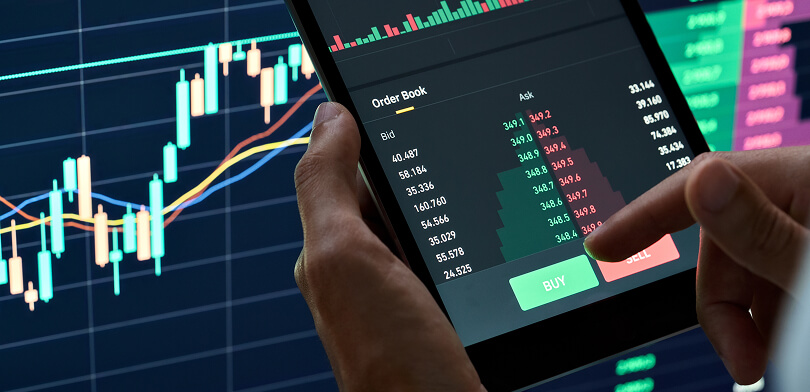Intraday trading is a very active and fast strategy of trading whereby the trader opens trades within a particular day of trading and closes it before the close of market hours. The idea is to take advantage of small price fluctuations of stocks and earn big amounts of money if such operations are done correctly. For a trader to earn profit in intraday trading, he must attain real-time data, updates, and analysis. This article will focus on discussing the need for Live intraday trading updates and give you a list of intraday trading stocks, the tools, and methods to enable traders to stay ahead.
Topics Covered :
- Understanding Intraday Trading
- Key Concepts in Intraday Trading
- The Importance of Live Intraday Trading Updates
- Essential Live Intraday Trading Resources
- Mastering Intraday Analysis Techniques
- Top Intraday Trading Stocks List
- Tools and Strategies for Effective Intraday Trading
- Building a Winning Intraday Trading Strategy
- Conclusion
Understanding Intraday Trading
Day or intraday trading focuses on the buying and selling of financial assets within the trading day. This strategy is used for quick gains and not holding an open position, hence avoiding long-term changes that may affect the prices. Day trading requires traders to have adequate knowledge and skills within the shortest time possible, where aspects such as market trends, charts, and economic indicators can be of great help to the trader. Risk management is important in shielding capital from volatile market risk. Traders employ some strategies like stop-loss order and position sizing to minimize possible loss and increase possible profits. One disadvantage of intraday trading is that it calls for constant monitoring of the market and trading news feeds; and secondly, discipline in the implementation of the intended trading strategies at any time or any hour of the day due to the volatility of prices in intraday trading.
Here’s what sets intraday trading apart:
- Time Horizon: Positions are opened and closed within the same trading day, exploiting short-term price movements.
- Trading Frequency: Intraday traders execute numerous trades throughout the day, aiming to generate profits from small price changes.
- Technical Analysis: Technical indicators and chart patterns become the primary tools for decision-making, with less emphasis on company fundamentals.
Key Concepts in Intraday Trading
- Liquidity: Liquidity is defined as the capacity of a stock in the market to be either bought or sold without fleshing out its cost. High/very active stocks are preferred in intraday trading because they guarantee the trader a quick entry and exit point.
- Volatility: A new concept in evaluating a stock is volatility which reflects the level of price oscillations in the stock. Intraday traders are normally more comfortable, and the least stressed by volatility since this means more income from price swings.
- Leverage: Gearing is using funds to raise the anticipated return on capital. Gearing significantly lowers your risk-reward ratio as it can help you gain and lose more.
- Technical Analysis: Intraday traders conduct a vast amount of technical analysis focusing on price charts and price forecasting.
The Importance of Live Intraday Trading Updates
It is very important to have real-time updates of intraday trading for appropriate decision-making to take place. The application of real-time data and analysis can provide traders with information on the best and most risky trades to make and how they can react in real time to market changes. Here are some key benefits of live updates:
- Timely Information: They give the most current information on the stock market, stock prices, and other market and business events. This enables the traders to be at the forefront and act fast to benefit from the arising incidences.
- Risk Management: Real-time updates allow the traders to closely track their positions and place stop loss to mitigate on chances of higher loss. This is even more relevant if the market is volatile, as this means that the prices within a short time may change dramatically.
- Enhanced Analysis: Real-time data makes it easier for the trader to do technical analysis on price charts and helps look at cycles and other chronological data patterns.
- Market Sentiment: The real-time updating offers information helping traders understand the generalized trend of the market mood so that they can timely adjust their ideas.
Essential Live Intraday Trading Resources
Several resources are available to equip you with the live updates and analysis needed for successful intraday trading. Here are some key options:
- Financial News Websites: Major financial news websites provide real-time market updates, breaking news alerts, and expert analysis. Look for platforms offering dedicated intraday trading sections.
- Stock Market Apps: Mobile applications from brokerage firms and financial data providers offer live stock quotes, charting tools, and real-time news feeds on the go.
- Financial Data Feeds: Dedicated financial data feeds offer a plethora of intraday data, including technical indicators, and historical price data for in-depth analysis.
- Stock Screeners: Stock screeners allow you to filter stocks based on specific criteria, such as price volatility, sector performance, and news mentions, helping you identify potential intraday trading opportunities.
Mastering Intraday Analysis Techniques
The intraday analysis focuses on technical indicators and chart patterns to forecast short-term price movements. These techniques equip you to interpret market data and make informed trading decisions. Here are some key areas to consider:
- Technical Indicators: Moving averages, relative strength index (RSI), and Bollinger Bands® are some popular technical indicators used to gauge price momentum, overbought/oversold conditions, and price volatility.
- Chart Patterns: Recognizable chart patterns like head and shoulders, double tops/bottoms, and breakout patterns can signal potential price reversals or continuations.
- Support and Resistance Levels: Identifying historical support and resistance levels on price charts can help predict areas where price movements might be restricted.
Top Intraday Trading Stocks List
Choosing the right stocks is a critical aspect of successful intraday trading. Here are some characteristics of ideal intraday trading stocks:
- High Liquidity: Stocks with high trading volumes ensure that traders can enter and exit positions quickly without significant price changes.
- Volatility: Stocks with high volatility provide more opportunities for intraday traders to profit from price movements.
- News Sensitivity: Stocks that are sensitive to news events and announcements can experience rapid price changes, offering opportunities for intraday gains.
Recommended Read: Choose Best Stock for Intraday Trading
Tools and Strategies for Effective Intraday Trading
Successful intraday trading requires a combination of the right tools and strategies. Here are some essential tools and strategies that can help traders stay ahead in the market:
Essential Tools for Intraday Trading
- Trading Platforms: Advanced trading platforms like MetaTrader, Thinkorswim, and Interactive Brokers provide real-time data, charting tools, and order execution capabilities.
- Charting Software: Tools like TradingView and NinjaTrader offer sophisticated charting capabilities and technical indicators to help traders analyze price movements.
- News Feeds: Real-time news feeds from sources like Bloomberg, Reuters, and CNBC provide the latest market news and developments.
- Screeners and Scanners: Stock screeners and scanners help traders identify stocks that meet specific criteria, such as high liquidity and volatility.
Building a Winning Intraday Trading Strategy
Developing a well-defined intraday trading strategy is crucial for consistent success. Here are key elements to consider:
- Market Selection: Choose markets you understand and feel comfortable with. Start with liquid stocks with high trading volume to ensure smooth entry and exit points.
- Risk Management: Set clear stop-loss orders to limit potential losses on each trade. Define your risk tolerance and stick to it.
- Trade Size Management: Allocate a predetermined portion of your capital to each trade, ensuring you don’t overexpose yourself to risk.
- Discipline and Emotion Control: Intraday trading can be emotionally charged. It’s crucial to maintain discipline, stick to your trading plan, and avoid impulsive decisions.
- Backtesting and Paper Trading: Before deploying real capital, test your intraday strategy using historical data (backtesting) or simulated trades (paper trading) to refine your approach.
Conclusion
Intraday trading offers the potential for significant profits, but it requires a disciplined approach, quick decision-making, and access to real-time data and analysis. By staying informed with live intraday trading updates, choosing the right stocks, and utilizing effective tools and strategies, traders can enhance their chances of success in this fast-paced market. Remember, successful intraday trading is not about making profits on every trade but about developing a consistent and disciplined approach to capitalize on market opportunities.
Recommended Read: Intraday Trading Strategies

















